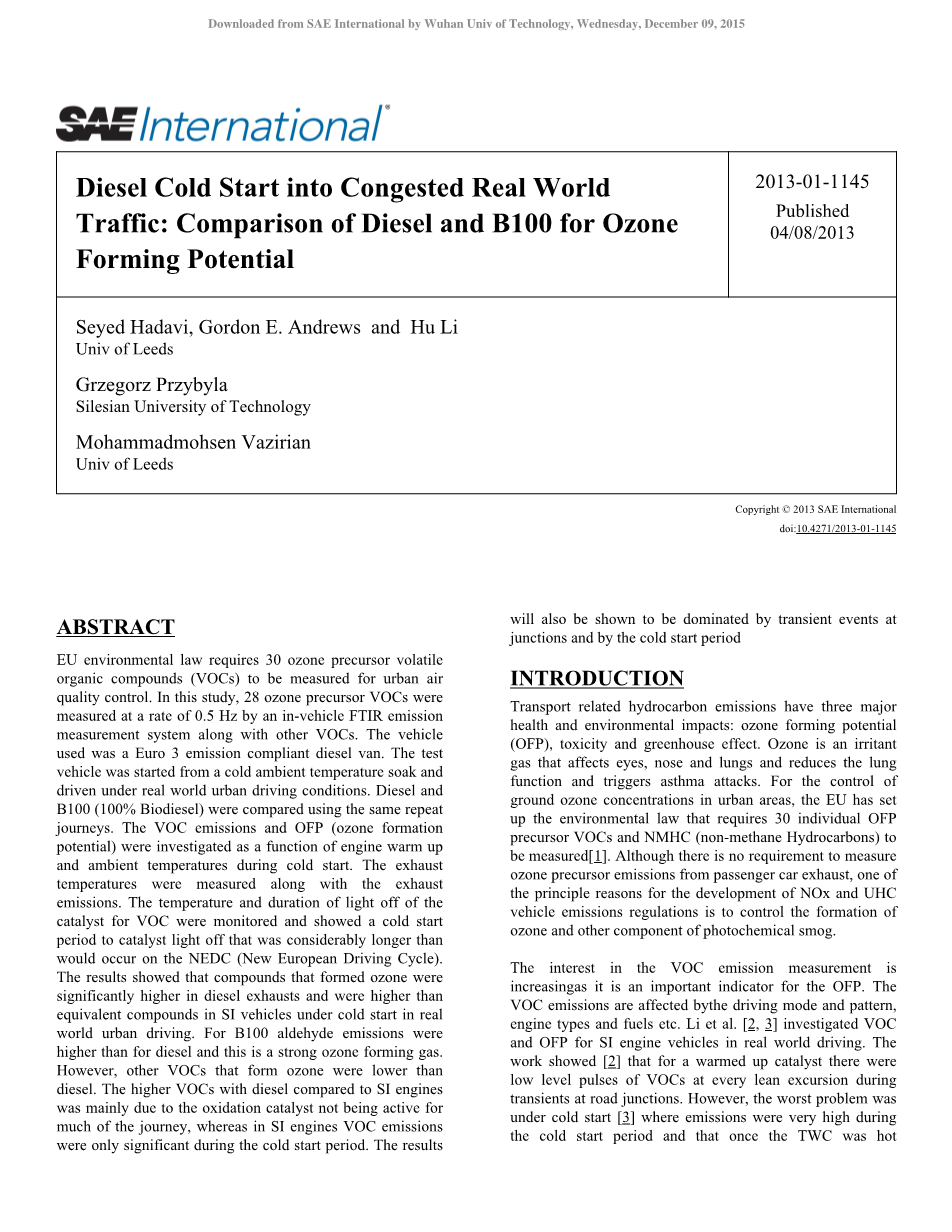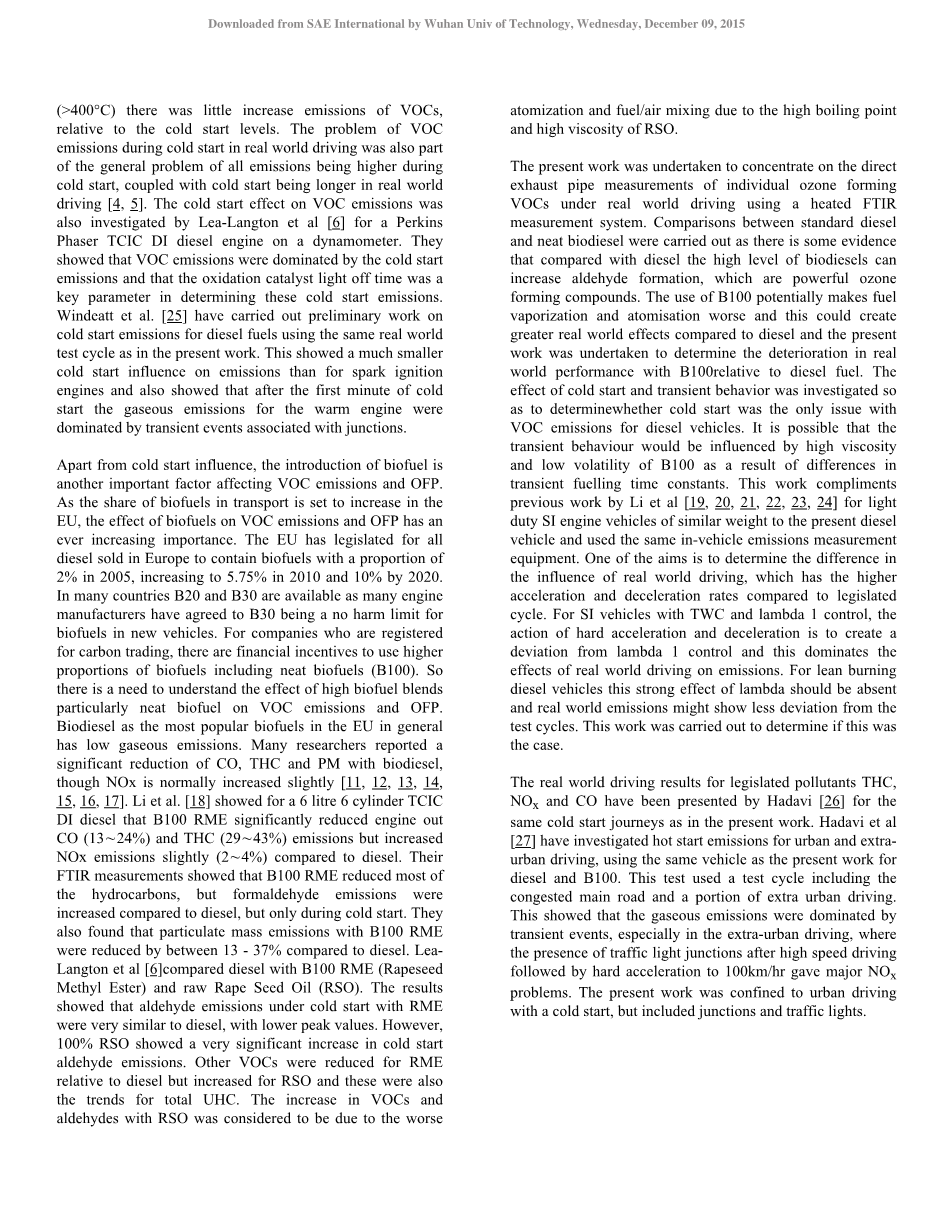柴油机VOCs致霾组分及其致霾机理研究外文翻译资料
2022-10-17 15:48:54


英语原文共 19 页,剩余内容已隐藏,支付完成后下载完整资料
Diesel Cold Start into Congested Real World
Traffic: Comparison of Diesel and B100 for Ozone Forming Potentia
ABSTRACT
EU environmental law requires 30 ozone precursor volatile organic compounds (VOCs) to be measured for urban air quality control.
In this study, 28 ozone precursor VOCs were
measured at a rate of 0.5 Hz by an in-vehicle FTIR emission measurement system along with other VOCs.
The vehicle used was a Euro 3 emission compliant diesel van.
The test vehicle was started from a cold ambient temperature soak and driven under real world urban driving conditions.
Diesel and B100 (100% Biodiesel) were compared using the same repeat journeys.
The VOC emissions and OFP (ozone formation
potential) were investigated as a function of engine warm up and ambient temperatures during cold start.
The exhaust temperatures were measured along with the exhaust emissions.
The temperature and duration of light off of the catalyst for VOC were monitored and showed a cold start period to catalyst light off that was considerably longer than would occur on the NEDC (New European Driving Cycle).
The results showed that compounds that formed ozone were significantly higher in diesel exhausts and were higher than equivalent compounds in SI vehicles under cold start in real world urban driving.
For B100 aldehyde emissions were higher than for diesel and this is a strong ozone forming gas.
However, other VOCs that form ozone were lower than diesel.
The higher VOCs with diesel compared to SI engines比较柴油和B100对臭氧形成潜在作用的大小。
摘要:
欧盟环境法需要测量30个臭氧前体挥发性有机化合物(挥发性有机化合物)来达到对城市空气质量的控制。
在这项研究中,通过车载式红外发射测量系统测得28个臭氧前体的挥发性有机化合物与其他挥发性有机物以0.5赫兹的速率运动。
试验使用车辆是满足欧Ⅲ排放的柴油货车。
试验车是从一个寒冷的环境温度下,在现实世界的城市道路工况驾驶条件下,行驶。
柴油(100%生物柴油B100)在相同的重复的路程条件下比较。
在冷启动过程中,挥发性有机化合物的排放量和OFP(臭氧的形成),作为发动机预热温度和环境温度是有函数关系。
排气温度随着废气排放进行测量。
对voc光催化剂的温度和时间的监测表明
,在冷启动期间光催化剂反应要比在NEDC(新欧洲行驶循环)发生的时间长很多。结果表明,化合物形成臭氧的柴油排放的显著提高,均高于实际城市道路工况冷启动的SI车辆。
对于B100醛的排放高于柴油,促进臭氧形成。
然而,其他挥发性有机化合物,形成臭氧均低于柴油。
柴油机产生的高挥发性有机化合物与SI发动机相比主要是由氧化催化剂在整个运动
was mainly due to the oxidation catalyst not being active for much of the journey, whereas in SI engines VOC emissions were only significant during the cold start period.
The results will also be shown to be dominated by transient events at junctions and by the cold start period
INTRODUCTION
Transport related hydrocarbon emissions have three major health and environmental impacts: ozone forming potential(OFP), toxicity and greenhouse effect.
Ozone is an irritant gas that affects eyes, nose and lungs and reduces the lung function and triggers asthma attacks.
For the control of ground ozone concentrations in urban areas, the EU has set up the environmental law that requires 30 individual OFP precursor VOCs and NMHC (non-methane Hydrocarbons) to be measured[1].
Although there is no requirement to measure
ozone precursor emissions from passenger car exhaust, one of the principle reasons for the development of NOx and UHC vehicle emissions regulations is to control the formation of ozone and other component of photochemical smog
The interest in the VOC emission measurement is increasing as it is an important indicator for the OFP
The VOC emissions are affected by the driving mode and pattern, engine types and fuels etc. Li et al. investigated VOC and OFP for SI engine vehicles in real world driving
The work showed that for a warmed up catalyst there were low level pulses of VOCs at every lean excursion during transients at road junctions
However, the worst problem was under cold
过程不够活跃,然而在汽油发动机中挥发性有机化合物的排放仅仅是在冷启动期间比较显著。由瞬态工况的突变情况及冷启动持续期决定。
简介
在运输中相关碳氢化合物的排放对健康和环境有三大方面的影响:臭氧的潜在形成,毒性气体和温室效应。
臭氧是一种刺激性气体,对眼睛、鼻子和肺有影响,损害肺功能,引发哮喘发作。
为了控制城市地面臭氧浓度,欧盟设立了环境法强制要求对30个特别的潜在形成的臭氧前体的高挥发性有机物和非甲烷碳氢化合物进行测量。
虽然没有要求测量轿车尾气中的臭氧前体排放,但是其中有一个原则性的原因是为了NOx和UHC的汽车尾气排放法规的发展以达到控制臭氧的形成和其他光化学烟雾成分。人们开始更加关注VOC排放的测量,是因为它对于臭氧的潜在形成是一项重要的研究指标。
高挥发性有机化合物的排放受行驶工况和驾驶模式以及发动机类型和燃料等影响。
研究了汽油发动机车辆实际行驶中的高挥发性有机化合物的排放和臭氧的潜在形成。
这项工作表明了一个预热的催化剂在整个瞬时路况的每一个倾斜的短途旅行中,存在一些较低水平的挥发性有机化合物的脉冲。
然而,最坏的问题是
start where emissions were very high during
the cold start period and that once the TWC was ho(gt;400°C) there was little increase emissions of VOCs,relative to the cold start levels.
The problem of VOC emissions during cold start in real world driving was also part of the general problem of all emissions being higher during cold start, coupled with cold start being longer in real world driving [4, 5]. The cold start effect on VOC emissions was also investigated by Lea-Langton et al [6] for a PerkinsPhaser TCIC DI diesel engine on a dynamometer.
They showed that VOC emissions were dominated by the cold start emissions and that the oxidation catalyst light off time was a
key parameter in determining these cold start emissions.
Windeatt et al. [25] have carried out preliminary work on cold start emissions for diesel fuels using the same real world test cycle as in the present work.
This showed a much smaller cold start influence on emissions than for spark ignition
engines and also showed that after the first minute of cold start the gaseous emissions for the warm engine were dominated by transient events associated with junctions.
Apart from cold start influence, the introduction of biofuel is another important factor affecting VOC emissions and OFP.
As the share of biofuels in transport is set to increase in the EU, the effect of biofuels on VOC emissions and OFP has an ever increasing importance.
The EU has legislated for all diesel sold in Europe to contain biofuels with a proportion of 2% in 2005, inc
剩余内容已隐藏,支付完成后下载完整资料
资料编号:[150989],资料为PDF文档或Word文档,PDF文档可免费转换为Word




